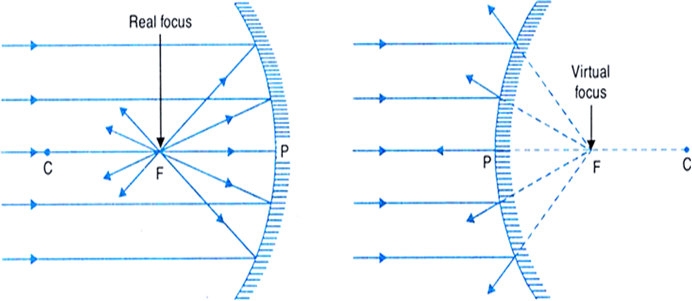
(i) Pole: It is the middle point P of the spherical mirror.
(ii) Centre of curvature: It is the centre C of the sphere of which the mirror forms a part.
(iii) Radius of curvature: It is the radius R (= AC or BC) of the sphere of which the mirror forms a part.
(iv) Principal axis: The line passing through the pole and the centre of curvature of mirror is called its principal axis.
(v) Linear aperture: It is the diameter AB of the circular boundary of the spherical mirror.
(vi) Angular aperture: It is the angle ACB subtended by the boundary of the spherical mirror at its centre of curvature.
(vii) Principle focus: It is a point F on the principal axis where a beam of light parallel to the principal axis either actually converges to or appears to diverge from, after reflection from a mirror.
Fig. Principal focus of (a) a concave mirror (b) a convex mirror
As shown in Fig.(a), when a beam of light is incident on a concave mirror parallel to its principal axis, it actually converges to a point F on the principal axis. So a concave mirror has a real focus and it is called a converging mirror also. As shown in Fig.(b), when a beam of light is incident on a convex mirror parallel to its principal axis, after reflection it appears to diverge from a point F (lying behind the mirror) on the principal axis. So a convex mirror has a virtual focus and it is called a diverging mirror also.
(viii) Focal length. It is the distance f (= PF) between the focus and the pole of the mirror.
(ix) Focal plane. The vertical plane passing through the principal focus and perpendicular to the principal axis is called focal plane. When a parallel beam of light is incident on a concave mirror at a small angle to the principal axis, it is converged to a point in the focal plane of the mirror.
Note: A line joining any point of the spherical mirror to its centre of curvature is always normal to the mirror at that point.
